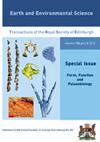高原沉降区生物标志物与铁形态的关系及其环境意义——以青藏高原东南部泸沽湖为例
IF 1.2
4区 地球科学
Q4 GEOSCIENCES, MULTIDISCIPLINARY
Earth and Environmental Science Transactions of the Royal Society of Edinburgh
Pub Date : 2020-12-01
DOI:10.1017/S1755691020000158
引用次数: 0
摘要
摘要本文结合泸沽湖沉积物样品中的铁(Fe)形态和生物标志物,研究了它们之间的关系及其环境意义。这些测量使用了穆斯堡尔谱和气相色谱-质谱法。结果表明:(a)Fe2+/Fe3+与三烷与植烷之比(Pr/Ph)呈强负相关,表明Fe2+/Fe3+和Pr/Ph分别有效地呈现了泸沽湖氧化-脱氧环境的无机和有机方面;(b) 除了氧化还原条件外,古温度可能是影响Fe2+/Fe3+比值的一个因素,它可能在古温度研究中发挥有利作用;(c)泸沽湖铁的相对丰度受古气候和沉积环境的影响。总面积(Mössbauer谱的总吸收面积)随古环境变化的机制似乎可以通过Fe的损失来解释,Fe的损失发生在水从湖泊中排出时,以及Fe从沉积物中的损失随着降雨量的增加而增加。本文章由计算机程序翻译,如有差异,请以英文原文为准。
Relationship between biomarkers and iron speciation and their environmental significance in plateau subsidence lacus: an example of Luguhu Lake, southeastern Tibetan Plateau
ABSTRACT Herein, we present a synthetic study combining iron (Fe) speciation and biomarkers in sediment samples from Luguhu Lake to investigate their relationship and the environmental significance thereof. Mössbauer spectroscopy and gas chromatography–mass spectrometry were used for these measurements. The results suggest that (a) there is a strong negative correlation between Fe2+/Fe3+ and the ratio of pristane to phytane (Pr/Ph), indicating that both Fe2+/Fe3+ and Pr/Ph effectively present the inorganic and organic aspects, respectively, of the oxidation–deoxidation environment in Luguhu Lake; (b) palaeotemperature may be a factor, in addition to the redox conditions, that affects the Fe2+/Fe3+ ratio, and it might play a favourable role in studies of palaeotemperature; and (c) the relative abundance of Fe in Luguhu Lake is affected by the palaeoclimate and the environment in which the palaeosediment was deposited. The mechanism of change in the total area (the total absorption area of Mössbauer spectrum) with the palaeoenvironment seems to be explained by the loss of Fe, which occurs as the water drains out of the lake, and the increase in Fe loss from the sediment as rainfall levels increase.
求助全文
通过发布文献求助,成功后即可免费获取论文全文。
去求助
来源期刊
CiteScore
2.00
自引率
0.00%
发文量
21
期刊介绍:
Earth and Environmental Science Transactions (formerly Transactions of the Royal Society of Edinburgh: Earth Sciences) is a general earth sciences journal publishing a comprehensive selection of substantial peer-reviewed research papers, reviews and short communications of international standard across the broad spectrum of the Earth and its surface environments. The journal prides itself on the quality of its graphics and photographic reproduction. The Editors are keen to encourage interdisciplinary papers and Transactions also publishes occasional special symposia and invited volumes of specific interest.
We are currently in the process of digitising the archive of RSE Publications, and the archive of the Transactions, dating back to 1788, will be available from the back issues link on this site.

 求助内容:
求助内容: 应助结果提醒方式:
应助结果提醒方式:


